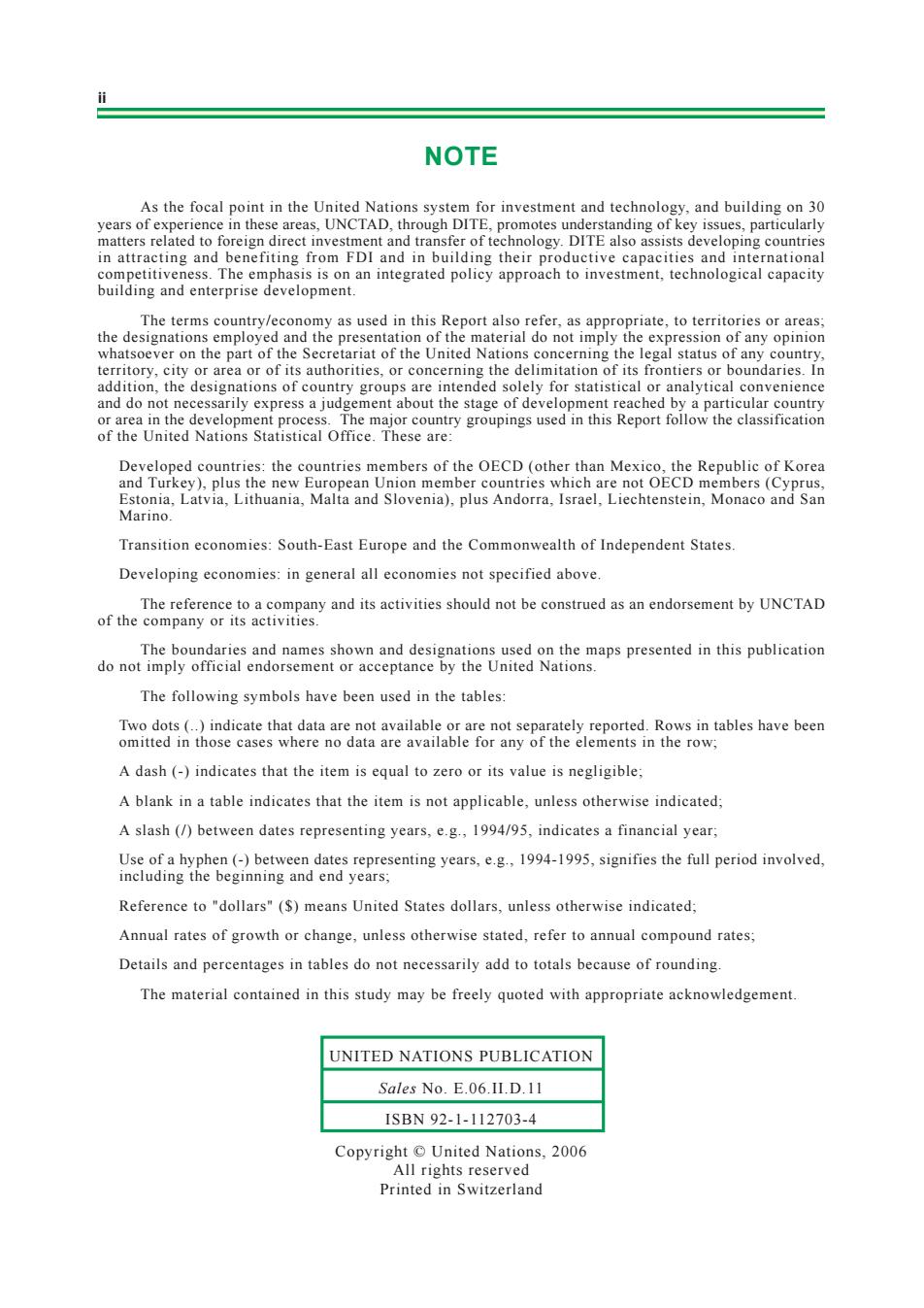正在加载图片...

NOTE ated n attracting and from FDI and in building their tive c apaeitend building and enterprise development hatso e of develo r statistic Transition economies:South-East Europe and the Commonwealth of Independent States Developing economies:in general all economies not specified above The ref endorsement by UNCTAD na The following symbols have been used in the tables A dash(-)indicates that the item is equal to zero or its value is negligible A blank in a table indicates that the item is not applicable,unless otherwise indicated. A slash()between dates representing years,e.g1994/95,indicates a financial year. yr-195 the full. Reference to"dollars"()means United States dollars.unless otherwise indicated. Annual rates of growth or change.unless otherwise stated.refer to annual compound rates Details and percentages in tables do not necessarily add to totals because of rounding. The material contained in this study may be freely quoted with appropriate acknowledgement UNITED NATIONS PUBLICATION Sales No.E.06.ILD.11 1SBN92-1-112703-4 Printed in Switzerland ii NOTE As the focal point in the United Nations system for investment and technology, and building on 30 years of experience in these areas, UNCTAD, through DITE, promotes understanding of key issues, particularly matters related to foreign direct investment and transfer of technology. DITE also assists developing countries in attracting and benefiting from FDI and in building their productive capacities and international competitiveness. The emphasis is on an integrated policy approach to investment, technological capacity building and enterprise development. The terms country/economy as used in this Report also refer, as appropriate, to territories or areas; the designations employed and the presentation of the material do not imply the expression of any opinion whatsoever on the part of the Secretariat of the United Nations concerning the legal status of any country, territory, city or area or of its authorities, or concerning the delimitation of its frontiers or boundaries. In addition, the designations of country groups are intended solely for statistical or analytical convenience and do not necessarily express a judgement about the stage of development reached by a particular country or area in the development process. The major country groupings used in this Report follow the classification of the United Nations Statistical Office. These are: Developed countries: the countries members of the OECD (other than Mexico, the Republic of Korea and Turkey), plus the new European Union member countries which are not OECD members (Cyprus, Estonia, Latvia, Lithuania, Malta and Slovenia), plus Andorra, Israel, Liechtenstein, Monaco and San Marino. Transition economies: South-East Europe and the Commonwealth of Independent States. Developing economies: in general all economies not specified above. The reference to a company and its activities should not be construed as an endorsement by UNCTAD of the company or its activities. The boundaries and names shown and designations used on the maps presented in this publication do not imply official endorsement or acceptance by the United Nations. The following symbols have been used in the tables: Two dots (..) indicate that data are not available or are not separately reported. Rows in tables have been omitted in those cases where no data are available for any of the elements in the row; A dash (-) indicates that the item is equal to zero or its value is negligible; A blank in a table indicates that the item is not applicable, unless otherwise indicated; A slash (/) between dates representing years, e.g., 1994/95, indicates a financial year; Use of a hyphen (-) between dates representing years, e.g., 1994-1995, signifies the full period involved, including the beginning and end years; Reference to "dollars" ($) means United States dollars, unless otherwise indicated; Annual rates of growth or change, unless otherwise stated, refer to annual compound rates; Details and percentages in tables do not necessarily add to totals because of rounding. The material contained in this study may be freely quoted with appropriate acknowledgement. UNITED NATIONS PUBLICATION Sales No. E.06.II.D.11 ISBN 92-1-112703-4 Copyright © United Nations, 2006 All rights reserved Printed in Switzerland